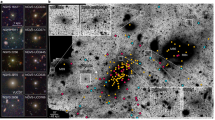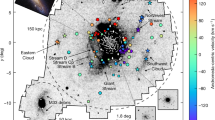Abstract
In hierarchical cosmological models1, galaxies grow in mass through the continual accretion of smaller ones. The tidal disruption of these systems is expected to result in loosely bound stars surrounding the galaxy, at distances that reach 10–100 times the radius of the central disk2,3. The number, luminosity and morphology of the relics of this process provide significant clues to galaxy formation history4, but obtaining a comprehensive survey of these components is difficult because of their intrinsic faintness and vast extent. Here we report a panoramic survey of the Andromeda galaxy (M31). We detect stars and coherent structures that are almost certainly remnants of dwarf galaxies destroyed by the tidal field of M31. An improved census of their surviving counterparts implies that three-quarters of M31’s satellites brighter than Mv = -6 await discovery. The brightest companion, Triangulum (M33), is surrounded by a stellar structure that provides persuasive evidence for a recent encounter with M31. This panorama of galaxy structure directly confirms the basic tenets of the hierarchical galaxy formation model and reveals the shared history of M31 and M33 in the unceasing build-up of galaxies.
This is a preview of subscription content, access via your institution
Access options
Subscribe to this journal
Receive 51 print issues and online access
$199.00 per year
only $3.90 per issue
Buy this article
- Purchase on Springer Link
- Instant access to full article PDF
Prices may be subject to local taxes which are calculated during checkout



Similar content being viewed by others
References
White, S. D. M. & Rees, M. J. Core condensation in heavy halos—a two-stage theory for galaxy formation and clustering. Mon. Not. R. Astron. Soc. 183, 341–358 (1978)
Bullock, J. S. & Johnston, K. V. Tracing galaxy formation with stellar halos. I. Methods. Astrophys. J. 635, 931–949 (2005)
Abadi, M. G., Navarro, J. F. & Steinmetz, M. Stars beyond galaxies: the origin of extended luminous haloes around galaxies. Mon. Not. R. Astron. Soc. 365, 747–758 (2006)
Johnston, K. V. et al. Tracing galaxy formation with stellar halos. II. Relating substructure in phase and abundance space to accretion histories. Astrophys. J. 689, 936–957 (2008)
Eggen, O. J., Lynden-Bell, D. & Sandage, A. R. Evidence from the motions of old stars that the Galaxy collapsed. Astrophys. J. 136, 748–766 (1962)
Searle, L. & Zinn, R. Compositions of halo clusters and the formation of the galactic halo. Astrophys. J. 225, 357–379 (1978)
Ibata, R. A., Gilmore, G. & Irwin, M. J. A dwarf satellite galaxy in Sagittarius. Nature 370, 194–196 (1994)
Klypin, A., Kravtsov, A. V., Valenzuela, O. & Prada, F. Where are the missing galactic satellites? Astrophys. J. 522, 82–92 (1999)
Moore, B. et al. Dark matter substructure within galactic halos. Astrophys. J. 524, L19–L22 (1999)
Bullock, J. S., Kravtsov, A. V. & Weinberg, D. H. Reionization and the abundance of galactic satellites. Astrophys. J. 539, 517–521 (2000)
Kravtsov, A. V., Gnedin, O. Y. & Klypin, A. A. The tumultuous lives of galactic dwarfs and the missing satellites problem. Astrophys. J. 609, 482–497 (2004)
Belokurov, V. et al. The field of streams: Sagittarius and its siblings. Astrophys. J. 642, L137–L140 (2006)
Ibata, R., Irwin, M., Lewis, G., Ferguson, A. M. N. & Tanvir, N. A giant stream of metal-rich stars in the halo of the galaxy M31. Nature 412, 49–52 (2001)
Ferguson, A. M. N., Irwin, M. J., Ibata, R. A., Lewis, G. F. & Tanvir, N. R. Evidence for stellar substructure in the halo and outer disk of M31. Astron. J. 124, 1452–1463 (2002)
Martin, N. F. et al. Discovery and analysis of three faint dwarf galaxies and a globular cluster in the outer halo of the Andromeda galaxy. Mon. Not. R. Astron. Soc. 371, 1983–1991 (2006)
Ibata, R. et al. The haunted halos of Andromeda and Triangulum: a panorama of galaxy formation in action. Astrophys. J. 671, 1591–1623 (2007)
McConnachie, A. W. et al. A trio of new Local Group galaxies with extreme properties. Astrophys. J. 688, 1009–1020 (2008)
Johnston, K. V., Hernquist, L. & Bolte, M. Fossil signatures of ancient accretion events in the halo. Astrophys. J. 465, 278–287 (1996)
Thilker, D. A. et al. On the continuing formation of the Andromeda galaxy: detection of H i clouds in the M31 halo. Astrophys. J. 601, L39–L42 (2004)
Schechter, P. An analytic expression for the luminosity function for galaxies. Astrophys. J. 203, 297–306 (1976)
Rogstad, D. H., Wright, M. C. H. & Lockhart, I. A. Aperture synthesis of neutral hydrogen in the galaxy M33. Astrophys. J. 204, 703–711 (1976)
Corbelli, E. & Schneider, S. E. A warped disk model for M33 and the 21 centimeter line width in spiral galaxies. Astrophys. J. 479, 244–257 (1997)
Brunthaler, A., Reid, M. J., Falcke, H., Greenhill, L. J. & Henkel, C. The Geometric distance and proper motion of the Triangulum Galaxy (M33). Science 307, 1440–1443 (2005)
Loeb, A., Reid, M. J., Brunthaler, A. & Falcke, H. Constraints on the proper motion of the Andromeda galaxy based on the survival of its satellite M33. Astrophys. J. 633, 894–898 (2005)
Dubinski, J. A parallel tree code. N. Astron. 1, 133–147 (1996)
McConnachie, A. W. et al. Distances and metallicities for 17 Local Group galaxies. Mon. Not. R. Astron. Soc. 356, 979–997 (2005)
Richardson, J. C. et al. The nature and origin of substructure in the outskirts of M31. I. Surveying the stellar content with the Hubble Space Telescope Advanced Camera for Surveys. Astron. J. 135, 1998–2012 (2008)
Ibata, R. et al. On the accretion origin of a vast extended stellar disk around the Andromeda galaxy. Astrophys. J. 634, 287–313 (2005)
Dotter, A. et al. The Dartmouth stellar evolution database. Astrophys. J. Suppl. Ser. 178, 89–101 (2008)
Widrow, L. M., Pym, B. & Dubinski, J. Dynamical blueprints for galaxies. Astrophys. J. 679, 1239–1259 (2008)
Acknowledgements
We thank the entire staff at the Canada–France–Hawaii Telescope for taking the data, for initial processing with Elixir and for their continuing support throughout this project. A.M.N.F. and A.D.M. are supported by a Marie Curie Excellence Grant from the European Commission under contract MCEXT-CT-2005-025869. G.F.L. thanks the Australian Nuclear Science and Technology Organisation (ANSTO) for supporting his involvement in PAndAS through its Access to Major Research Facilities Program (AMRFP). R.M.R. acknowledges grant AST-0709479 from the National Science Foundation, and grants GO-9453, GO-10265 and GO-10816 from the Space Telescope Science Institute. The image of M33 overlaid in Fig. 1 is reproduced by courtesy of T. A. Rector and M. Hanna.
Author Contributions All authors assisted in the development and writing of the paper. In addition, A.W.M. is the Principal Investigator of PAndAS; M.J.I. led the data processing effort; R.A.I. was the Principal Investigator of an earlier CFHT MegaPrime/MegaCam survey, which PAndAS builds on (which included S.C.C., A.M.N.F., M.J.I., G.F.L., N.F.M., A.W.M. and N.T.); J.D., L.M.W. modelled the M31–M33 interaction; N.F.M. had a lead role in the study of the dwarf galaxies; P.C. assisted with constructing the luminosity function; and A.L.D. developed the theoretical isochrones.
Author information
Authors and Affiliations
Corresponding author
Supplementary information
Supplementary Information
This file contains a Supplementary Discussion, Supplementary Methods and Supplementary Tables 1-2. (PDF 135 kb)
Supplementary Movie 1
This animated movie depicts a model of the interaction of M31 and M33 highlighting the excitation of tidal tails as the plausible origin of the extensions of the M33 stellar disk and gaseous warp. The tidal stripping of the M33 stellar halo is not the likely origin of the observed extensions. (MOV 9842 kb)
Rights and permissions
About this article
Cite this article
McConnachie, A., Irwin, M., Ibata, R. et al. The remnants of galaxy formation from a panoramic survey of the region around M31. Nature 461, 66–69 (2009). https://doi.org/10.1038/nature08327
Received:
Accepted:
Issue Date:
DOI: https://doi.org/10.1038/nature08327
This article is cited by
-
The evolution of CNO elements in galaxies
The Astronomy and Astrophysics Review (2022)
-
The recurrent impact of the Sagittarius dwarf on the star formation history of the Milky Way
Nature Astronomy (2020)
-
The mass of our Milky Way
Science China Physics, Mechanics & Astronomy (2020)
-
Two major accretion epochs in M31 from two distinct populations of globular clusters
Nature (2019)
-
Toward an Internally Consistent Astronomical Distance Scale
Space Science Reviews (2017)
Comments
By submitting a comment you agree to abide by our Terms and Community Guidelines. If you find something abusive or that does not comply with our terms or guidelines please flag it as inappropriate.



